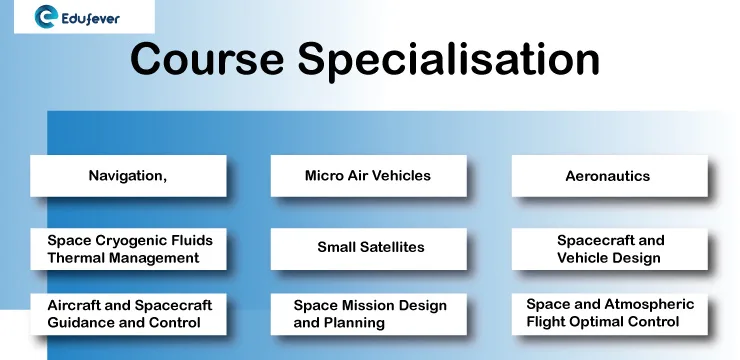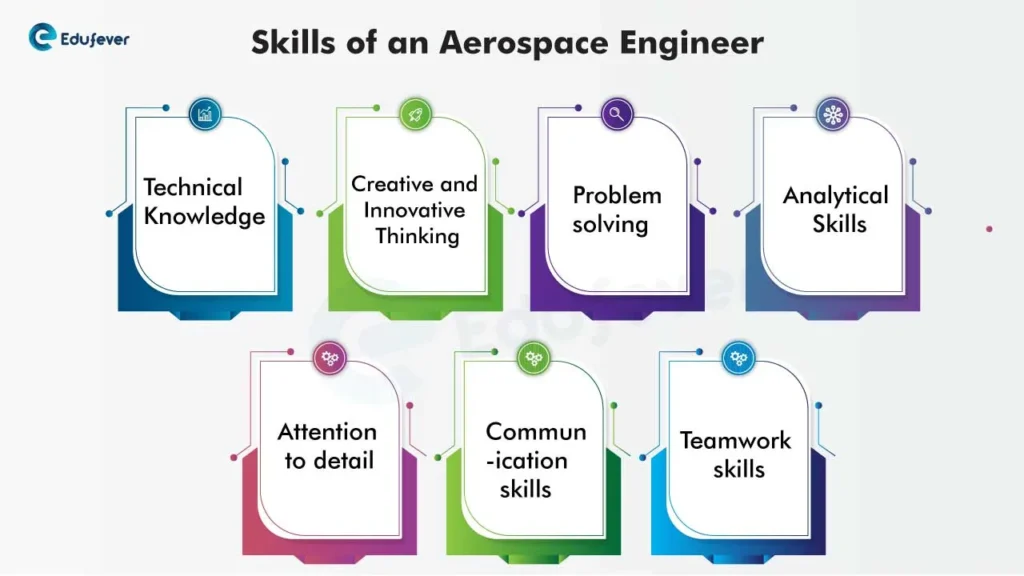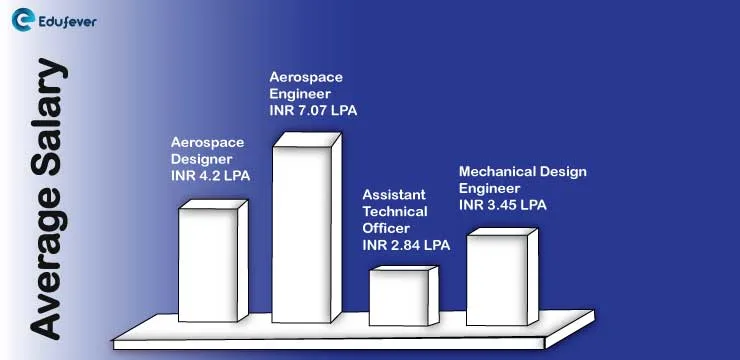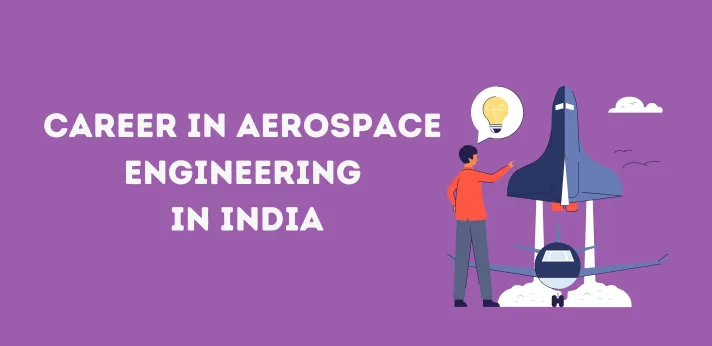Career in Aerospace Engineering in India: As children, we have dreamt of becoming pilots or astronauts. But for those who are adults now and still hold the same dream, aerospace engineering is your stream. At first, this branch was known as aeronautical engineering. However, because of technological advancement, it is now universally termed as Aerospace Engineering.
Aerospace engineering covers two main sectors – Aeronautical Engineering and Astronautical engineering. It is known among the toughest engineering branches. An aerospace engineer learns everything from building a small propeller to working on rockets and space shuttles. In addition, they also study numerous aircraft and spaceships. Aerospace engineers are true experts in in-flight technology. In the modern world, aircraft are used in travelling, shipping, war, recon or various research activities. Readers will learn about aerospace engineering through this article, like admission, eligibility, entrance exams, colleges, scope and more.
[Index]
What is Aerospace Engineering?
Aerospace engineering deals with designing and building machines that can fly and is one of the newest branches of engineering. The course prepares students with the basic concepts of aerodynamics and knowledge of aircraft power plants. The work of an aerospace engineer includes designing aircraft, spacecraft, satellites and missiles and testing prototypes to make sure that they function according to the plans.
Course Highlight
In the following table, we have mentioned aerospace engineering courses.
| Particulars | Description |
|---|---|
| Course Name | B.E/B.Tech M.E/M.Tech Diploma PhD |
| Duration | UG: 4 years PG: 3 years PhD: 3 years |
| Average Fees | Government Colleges: 5.6 lakhs INR Private Colleges: 3.5 lakhs INR |
| Course Specialisation | Aircraft and Spacecraft Guidance and Control Small Satellites, Navigation, Aeronautics |
| Job Profile | Aerospace Engineer, Data Processing Manager, Data Processing Manager, Maintenance Engineer, Mechanical Engineer |
| Top Recruiters | Eaton, Rolls Royce, Honeywell, Timetooth Technologies, Zeus Numerix |
Eligibility Criteria
- For the undergraduate level, The candidate must have cleared the 12th with Physics, Chemistry, and Mathematics with a minimum of 60% marks required.
- A degree of B.Tech in the same discipline is required for the postgraduate level, with a minimum CPI of 6.5 or 60% marks in B.tech mandatory. Minimum qualifying marks in GATE ME.
- There are various Entrance Exams for Aerospace Engineering, you will need to score a minimum qualifying mark in entrance exams.
Entrance Exams for Aerospace Engineering
Here is the list of Entrance exams for Aerospace Engineering. Here we have mentioned only the important and most known exams conducted by various bodies for engineering courses.
| Entrance Exam | Conducted By |
| JEE Main | National Test Agency |
| VITEEE | VIT University |
| BITSAT | Birla Institute of Technology and Science |
| MU OET | Manipal University |
| KIITEE | Kalinga Institute of Industrial Technology |
| AUCET | Andhra University |
Top Colleges for Aerospace Engineering
Here is the list of top colleges offering Aerospace Engineering in India.
| SNO | College Name | Location |
|---|---|---|
| 1 | Indian Institute of Technology | Bombay |
| 2 | Indian Institute of Technology | Kanpur |
| 3 | Manipal University | Manipal |
| 4 | SRM | Chennai |
| 5 | Indian Institute of Technology, Chennai | Chennai |
| 6 | Birla Insitute Of Technology | Ranchi |
| 7 | Indian Institute of Space Science and Technology | Thiruvananthapuram |
Fee Structure
The fee structure for undergraduate (UG) and postgraduate (PG) courses in aerospace engineering is provided below. Please note that these fees may vary depending on whether you attend a private college or a government institution and remember that these are average fees and may be subject to change.
For Undergraduate
| College Sector | Fees in INR |
| Government Colleges | Min- 13,000 INR Avg- 5.6 lakhs INR Max- 16.3 Lakhs INR |
| Private Colleges | Min-40,000 INR Avg- 3.5 lakhs INR Max- 16.3 lakhs INR |
For Postgraduate
| College Sector | Fees in INR |
| Government Colleges | Min- 10,500 INR Avg- 1.25 Lakhs INR Max- 2.4 Lakhs INR |
| Private Colleges | Min-1 Lakhs INR Avg- 1.6 lakhs INR Max- 2.5 lakhs INR |
Syllabus
Below is the list of subjects and topics taught during the academic years of aerospace engineering. However, remember that these subjects/topics might change from college to college. So, if you find add-ons of any new subject or maybe a few topics less, don’t fret.
UG Syllabus for Aerospace Engineering
Here are the topics taught during undergraduate (UG) courses in aerospace engineering:
| S.No. | Chapter Name | S.No. | Chapter Name |
| 1. | Elements of Aeronautics. | 14. | Total Quality Management and Reliability engineering |
| 2. | Aero-Fluid Mechanics | 15. | Rocket Propulsion |
| 3. | Mechanics of Solids | 16. | Vibrations and Elements of Aeroelasticity |
| 4. | Aircraft Component Drawing | 17. | Helicopter Aerodynamics |
| 5. | Aerodynamics | 18. | Rockets and Missiles |
| 6. | Machines and Mechanisms | 19. | Combustion Engineering |
| 7. | Aircraft Systems and Instruments | 20. | Theory of Plates and Shells |
| 8. | Air-breathing Propulsion | 21. | Computer-aided design and analysis |
| 9. | Aerodynamics Laboratory | 22. | Automatic Control System |
| 10. | Introduction to Space Tech | 23. | Spacecraft technology |
| 11. | Aircraft Structure Designing and Building | 24. | Aircraft Materials |
| 12. | Flight Dynamics | 25. | Fatigue and Fracture Mechanics |
| 13. | Heat Transfer |
PG syllabus for aerospace engineering
Here are the topics taught during Postgraduation (PG) courses in aerospace engineering:
| Engineering Aerodynamics and Flight Mechanics | Aerodynamic Design |
| Advanced aerodynamics | Elements of Gas Dynamics and Propulsion |
| Numerical Methods in Gas Dynamics | Helicopter Aerodynamics |
| Hypersonic Air-Breathing Propulsion | Thermal Stress Analysis |
| Aero Elasticity | Grid Generation |
| Mechanics of Damage Tolerance | Non-Linear Behavior of Plates and Shells |
| Elastic Stability | – |
Course Specialisation
Below is the list of Specialisation courses in the field of aerospace engineering:
| Aircraft and Spacecraft Guidance and Control | Small Satellites |
| Micro Air Vehicles | Optimization Techniques for Aerospace Systems |
| Space and Atmospheric Flight Optimal Control | Space Cryogenic Fluids Thermal Management |
| Space Environment Modeling | Navigation |
| Space Mission Design and Planning | Spacecraft and Vehicle Design |
| Aeronautics | – |

Career in Aerospace Engineering
In India, the aviation industry is growing day by day, therefore there are a lot of opportunities in aerospace engineering. With advancements in technology, sectors such as space research, rocket manufacturing, cargo transportation, passenger aircraft, helicopter services, defence services, and more are actively recruiting aerospace engineers.
Job Profile
| Aerospace Engineer | Data Processing Manager |
| Data Processing Manager | Maintenance Engineer |
| Mechanical Engineer | Aircraft or Spacecraft Designers |
| Military | Industrial Engineer |

Roles of an Aerospace Engineer
- Utilize scientific and technological principles to develop aircraft, components, and support equipment.
- Research and develop design specifications and use computer-aided design (CAD) software to create plans.
- Resolve issues that arise during the design, development and testing processes.
- Supervise the assembly of airframes and the installation of engines, instruments and other equipment.
- Measure and improve the performance of aircraft, components and systems
Skills of an Aerospace Engineer
- Technical Knowledge
- Creative and Innovative Thinking
- Problem-solving
- Analytical Skills
- Attention to detail
- Communication skills
- Teamwork skills

Salary of an Aerospace Engineer
The following is the salary for an aerospace engineer at different job profiles:
| Job Profile | Average Salary |
|---|---|
| Aerospace Designer | INR 4.2 LPA |
| Aerospace Engineer | INR 7.07 LPA |
| Assistant Technical Officer | INR 2.84 LPA |
| Mechanical Design Engineer | INR 3.45 LPA |

Pros and Cons of Aerospace Engineering
The followings are the advantages and disadvantages of aerospace engineering:
| Advantages | Disadvantages |
|---|---|
| The most important factor would be the high pay scale. Aerospace engineers are one of the highest-paid job responsibilities not just in India but across the globe. | Sometimes aerospace engineers might travel all over the country to find productive projects. |
| There is a high level of job gratification, in addition to the emotional satisfaction of achievement. | They can devise innovative devices not confined to aircraft, spacecraft, missiles, or over and above advanced-technology fresh government ventures. |
| This job profile is location-specific. In short, it requires an engineer to shift his/her family’s base and start afresh. Therefore, resettling can be a concern. | It could be full of anxiety and stress, as completing a project is a handful of tasks. |
Top Recruiters
Famous organisations like TAS, Airbus and ISRO are some of the major recruiters that hire aerospace engineers. With numerous aircraft industries, India offers excellent placement opportunities for aeronautical engineers. Some of the few companies that hire an aerospace engineer are as follows:
| National Aerospace Laboratories | Eaton |
| Rolls Royce | Honeywell |
| Timetooth Technologies | Zeus Numerix |
| Ansys | Infotech Enterprises |

Frequently Asked Questions (FAQs)
What are the major sectors that hire a graduate aerospace engineer?
Defence, cargo shipment, private airlines, and space research are a few sectors that recruit an expert from this field engineer.
Will I get good pay in India if I join an aerospace engineering course?
This field holds a fantastic job possibility in India. If you are an experienced person, you can quickly get an excellent salary package. An aerospace engineer can earn up to Rs 45,000/- monthly.
Can I join ISRO after doing aerospace engineering?
To join ISRO, candidates must qualify for the annual exam. The recruitment for aerospace engineers in ISRO is also through an entrance test.
